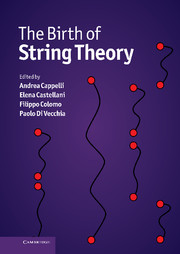Book contents
- Frontmatter
- Contents
- List of contributors
- Photographs of contributors
- Preface
- Abbreviations and acronyms
- Part I Overview
- EARLY STRING THEORY
- Part II The prehistory: the analytic S-matrix
- Part III The Dual Resonance Model
- Part IV The string
- TOWARDS MODERN STRING THEORY
- Part V Beyond the bosonic string
- Part VI The superstring
- 35 Introduction to Part VI
- 36 Supersymmetry in string theory
- 37 Gravity from strings: personal reminiscences of early developments
- 38 From the Nambu–Goto to the σ-model action
- 39 Locally supersymmetric action for the superstring
- 40 Personal recollections
- 41 The scientific contributions of Joël Scherk
- Part VII Preparing the string renaissance
- Appendix A Theoretical tools of the Sixties
- Appendix B The Veneziano amplitude
- Appendix C From the string action to the Dual Resonance Model
- Appendix D World-sheet and target-space supersymmetry
- Appendix E The field theory limit
- Index
40 - Personal recollections
from Part VI - The superstring
Published online by Cambridge University Press: 05 May 2012
- Frontmatter
- Contents
- List of contributors
- Photographs of contributors
- Preface
- Abbreviations and acronyms
- Part I Overview
- EARLY STRING THEORY
- Part II The prehistory: the analytic S-matrix
- Part III The Dual Resonance Model
- Part IV The string
- TOWARDS MODERN STRING THEORY
- Part V Beyond the bosonic string
- Part VI The superstring
- 35 Introduction to Part VI
- 36 Supersymmetry in string theory
- 37 Gravity from strings: personal reminiscences of early developments
- 38 From the Nambu–Goto to the σ-model action
- 39 Locally supersymmetric action for the superstring
- 40 Personal recollections
- 41 The scientific contributions of Joël Scherk
- Part VII Preparing the string renaissance
- Appendix A Theoretical tools of the Sixties
- Appendix B The Veneziano amplitude
- Appendix C From the string action to the Dual Resonance Model
- Appendix D World-sheet and target-space supersymmetry
- Appendix E The field theory limit
- Index
Summary
In 1969, I was finishing my PhD in Orsay under the supervision of Michel Gourdin on phenomenological works related to e+e- annihilations. These works allowed me to deepen my knowledge of particle physics as well as to learn how to master difficult calculations. However, I was more attracted by more formal research (which we would like to be able to say was more fundamental!). The theoretical physics laboratory in Orsay was also hit by the explosion of activity which followed the paper of Veneziano, and a group of people began to work on dual models: Bouchiat, Gervais, Nuyts, Amati who was spending a sabbatical in Orsay, as well as younger researchers Neveu, Scherk and Sourlas. My first encounter with dual models was to rebel against this too fashionable growing activity. With Jean Nuyts I asked whether there could be some other example of an s–t dual amplitude with only poles in both channels: we found an example with poles lying on a logarithmic trajectory instead of a linear one [CN71]. However, this amplitude led tomany unsatisfactory physical conclusions and I joined the mainstream.
Factorizing the Pomeron with Jöel Scherk at CERN
In 1970, much work was devoted to the dual multiloop amplitude, in particular by Kaku and Yu [KY70]. Lovelace [Lov70] and Alessandrini [Ale71] showed the relation between these amplitudes and the Neumann function associated with a sphere with handles.
- Type
- Chapter
- Information
- The Birth of String Theory , pp. 490 - 495Publisher: Cambridge University PressPrint publication year: 2012



